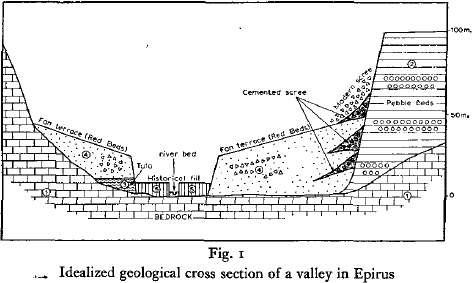Published online by Cambridge University Press: 27 May 2014
In 1965 the investigations described in the first paper of the series were resumed in Epirus. The excavation of the rock shelter of Asprochaliko was continued, and further geological observations made it possible to establish a continental sequence extending from the Last Interglacial to the present day.

The geological succession and its associated artifacts was worked out in the Louros valley (fig. 1) and confirmed in other parts of Epirus. It consists of the following three main formations:
3. Valley-floor Alluvium (pl. 1, upper). 2. Red Beds. 1. Tufa.
There are also extensive sheets of unconsolidated scree on the valley sides, as Hey has noted. These overlie the Red Beds, but as their relationship to the Valley-floor Alluvium is not known, and as the extent of contemporary scree formation (if any) is not yet clear, they cannot at this stage be placed in the succession.
page 1 note 1 Dakaris, S. I., Higgs, E. S. and Hey, R. W., ‘The Climate, Environment and Industries of Stone Age Greece’, Part 1. PPS, xxx, 1964, 199–244, 226, 228Google Scholar.
page 2 note 1 Dakaris, S. I., Higgs, E. S. and Hey, R. W., ‘The Climate, Environment and Industries of Stone Age Greece’, Part 1. PPS, xxx, 1964, 227–8Google Scholar.
page 2 note 2 ibid., 212.
page 3 note 1 Pettijohn, F. J., Sedimentary Rocks, Harper & Bros., N.Y., 2nd edition, 192–3.Google Scholar
page 3 note 2 Dakaris, S. I., Higgs, E. S. and Hey, R. W., ‘The Climate, Environment and Industries of Stone Age Greece’, Part 1. PPS, xxx, 1964, 213–29Google Scholar.
page 4 note 1 Tippett, H., PPS, xxx, 1964, 222–3Google Scholar.
page 5 note 1 ibid., 215–19.
page 6 note 1 Paraskevaidis, I., ‘Observations sur le Quaternaire de la Grèce’, Actes IV Cong. Int. Quat. (INQUA), Rome-Pisa, 1953—1956, 167–8Google Scholar, reports a Tyrrhenian beach near Preveza which is overlain by what would appear to be the Red Beds.
page 7 note 1 See, for example, Negris, P., La Regression Quatemaire, Athens, 1912Google Scholar, and ‘Les terrasses marines de la Grèce’, 1st Rep. Com. Plio. Pleist. Terr., ed. Sandford, K. S., Oxford, 1928, 18–26.Google ScholarMistardis, G. G., ‘Recherches sur l'influence des mouvement eustatiques du Quaternaire sur la morphologie de la zone côtière du nord du Peloponèse’, C.R. XVIII Cong. Int. Geog., Rio de Janeiro, 1956—vol. 2, 1960, 324–8, notes on p. 327Google Scholar the presence of red continental deposits over a 50-metre Tyrrhenian beach.
page 7 note 2 Probably the ‘neogene conglomerates’ mentioned by Mistardis, op. cit., 326.
page 8 note 1 7380±240 B.P. (I.1959).
page 8 note 2 Sestini, A., ‘Tracce glaciali nel Pindo epirota’, Boll. R. Soc. Geog. It., LXX, 136–56Google Scholar. Other references are discussed by Charlesworth, J. K., The Quaternary Era, vol. 2, Arnold, 1957, 296, 322, 652, 719 and 1220Google Scholar, and Butzer, K. W., Environment and Archeology, Methuen, London, 1965, 62, 102, 286Google Scholar.
page 8 note 3 Admiralty Handbook, Greece, vol. 3, 1945, 27Google Scholar.
page 8 note 4 Dakaris, Higgs and Hey, op. cit., 213.
page 9 note 1 Admiralty Handbook, Greece, vol. 3, 1945, 36Google Scholar.
page 22 note 1 Rodden, R. J., ‘Excavations at the Early Neolithic Site at Nea Nikomedeia, Greek Macedonia’, PPS, XXVIII, 1962Google Scholar.
page 23 note 1 Admiralty Handbook, Greece, vol. 3, 1945, 36Google Scholar.
page 23 note 2 Leroi-Gourhan, A., ‘Découvertes Paléolithiques en Élide’, Bull. de Corr. Hellenique, vol. 88, 1964Google Scholar.
page 23 note 3 Dakaris, Higgs and Hey, op. cit., 216 ff.
page 24 note 1 Milojčić, V., ‘Die neuen mittel und altpalaolithischen Funde der Balkan Halbinsel’, Germania, 36, 3/4, 1958, 319–24Google Scholar.
page 24 note 2 Stampfuss, R., ‘Die ersten altsteinzeitlichen Höhlenfunde in Griechenland’, Mannus, xxxiv, 1–2, 1942, 132–47Google Scholar.
page 24 note 3 Dakaris, Higgs and Hey, op. cit., 227 ff.
page 24 note 4 Hey, R. W., ‘The Quaternary and Palaeolithic of Northern Libya’, Quaternaria, vol. 6, 1962, 435–49Google Scholar.
page 24 note 5 Higgs, E. S., ‘Faunal Fluctuation and Climate in Libya’, Wenner-Gren Foundation, Burg Wartenstein Symposium, 1965Google Scholar, on ‘Systematic Investigation of the African Later Tertiary and Quaternary’.
page 25 note 1 For example on the Bioclimatic Map of the Mediterranean Region, FAO–UNESCO, 1962Google Scholar.
page 25 note 2 e.g. Vita-Finzi, C., ‘Observations on the Late Quaternary of Jordan’, Palestine Expl. Q., vol. 96, 1964, 19–33CrossRefGoogle Scholar. Wright, H. E. Jr., ‘Late Pleistocene Geology of Coastal Lebanon’, Quaternaria, VI, 1962, 525–39Google Scholar.
page 27 note 1 Vita-Finzi, C., ‘Synchronous stream deposition throughout the Mediterranean area in historical times’, Nature, vol. 202, 1964, 1324CrossRefGoogle Scholar.
page 27 note 2 Carr-Saunders, A. M., The Population Problem: A Study in Human Evolution, Oxford, 1922Google Scholar.
page 27 note 3 Wynne-Edwards, V. C., Animal Dispersion in Relation to Social Behaviour, Oliver and Boyd, 1962Google Scholar.
page 29 note 1 Wace, A. J. B. and Thompson, M. S., The Nomads of the Balkans, Methuen, 1913, 51Google Scholar.
page 29 note 2 vide Kitto, H. D. F., The Greeks, Pelican, 1951, 33–4Google Scholar.
page 29 note 3 Admiralty Handbook, Greece, vol. 3, 1945, 27Google Scholar.